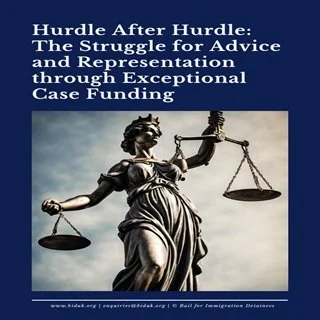By Sana Singh
For years, countless immigrant Californians have been calling attention to the California Department of Corrections and Rehabilitation’s (CDCR) discriminatory practices that assist in U.S. Immigration and Customs Enforcement’s (ICE) deportation efforts. CDCR staff identify individuals in their custody, whom CDCR assumes to be born outside of the U.S., report them to ICE, and deny them valuable rehabilitation, education, and credit-earning opportunities. In 2022, the ACLU of Northern California filed a major public records request seeking communications between CDCR and ICE. Over the past several months, the ACLU of Northern California, Asian Americans Advancing Justice-Asian Law Caucus, Asian Prisoner Support Committee, and Root & Rebound have analyzed over 2,500 CDCR records and emails between August and September 2022. Step by step, the team pieced together a more detailed view than ever before into how CDCR voluntarily goes to horrifying lengths to illegally discriminate against Californians born outside the U.S. and against anyone CDCR officers unilaterally perceive or assume to be born outside the U.S. Dozens of previously unseen emails show how California’s largest public agency is using public resources to operate a system of double punishment that rips apart immigrant and refugee families and communities, in direct conflict with California’s values of equality, fairness, and justice. In their zeal to collude with ICE, CDCR is not only targeting people who have served their time and are set to return home for detention and deportation but is also sweeping up U.S. citizens and Green Card holders, relying on racist assumptions and ignoring their own records. CDCR’s practices are also increasingly out of step with the rest of California and statewide officials’ own commitments to their constituents. Many counties across California, including Los Angeles, San Joaquin, Santa Cruz, Humboldt, San Francisco, San Mateo, and Santa Clara, have already stopped facilitating transfers of people to ICE after they have served their time in jail or prison. Governor Newsom has recently called on California to “be in the homecoming business,” and CDCR Secretary Macomber has stated his intentions to “create a space focused on preparing individuals for successful returns to the community.” CDCR’s practices raise urgent legal and policy questions and implicate the fundamental rights of numerous Californians in CDCR custody, adding further to the agency’s deeply troubling record of medical abuse and neglect, warehousing of people in long-term solitary confinement, racist and antisemitic social media comments, and forced sterilizations, among other concerning practices. The human costs of CDCR’s collusion with ICE are severe, as revealed in disturbing email records in the report that follows. By proactively offering people up to ICE, CDCR has engineered a two-tiered system of justice that brings trauma to those in their custody The emails reviewed by the investigative team and described below are communications from August and September 2022. Despite the narrow timeframe of these records, the records we have received paint a disturbing picture. In just the two months the below communications span, CDCR transferred over 200 people from CDCR facilities to ICE custody. What follows is a description of the practices that CDCR uses to collude with ICE, and examples of discrimination, indiscretion, resource mismanagement, and anti-immigrant behavior by department staff, as revealed in disturbing email records. We conclude with a summary of the harms caused and the need for legislative action. and to their loved ones. The impact of such discriminatory practices is felt widely in California, which is home to the largest immigrant population in the country. In 2021, over a quarter of Californians were foreign-born and almost half of the children in the state had at least one immigrant parent. In 2023, California lawmakers can take immediate action to hold CDCR accountable to the state’s values and laws. AB 1306 authored by Assemblymember Wendy Carrillo, otherwise known as the HOME Act, harmonizes state immigration policy with existing, broadly-supported criminal justice reforms, ensuring immigrant Californians who earn their release from state prison through these measures are not transferred to ICE. The legislation offers a simple fix to one form of CDCR’s discrimination against immigrants and refugees and takes important strides toward enacting equal treatment for all who call California home
San Francisco: ACLU of Northern California, 2023. 22p.





















